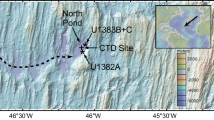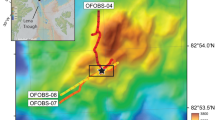Abstract
Hydrothermal vents on mid-ocean ridges of the northeast Pacific Ocean are known to respond to seismic disturbances, with observed changes in vent temperature1,2,3,4. But these disturbances resulted from submarine volcanic activity; until now, there have been no observations of the response of a vent system to non-magmatic, tectonic events. Here we report measurements of hydrothermal vent temperature from several vents on the Juan de Fuca ridge in June 1999, before, during and after an earthquake swarm of apparent tectonic origin. Vent fluid temperatures began to rise 4–11 days after the first earthquake. Following this initial increase, the vent temperatures oscillated for about a month before settling down to higher values. We also observed a tenfold increase in fluid output from the hydrothermal system over a period of at least 80 days, extending along the entire ridge segment. Such a large, segment-wide thermal response to relatively modest tectonic activity is surprising, and raises questions about the sources of excess heat and fluid, and the possible effect on vent biological communities.
This is a preview of subscription content, access via your institution
Access options
Subscribe to this journal
Receive 51 print issues and online access
$199.00 per year
only $3.90 per issue
Buy this article
- Purchase on Springer Link
- Instant access to full article PDF
Prices may be subject to local taxes which are calculated during checkout


Similar content being viewed by others
References
Fox, C. G., Dziak, R. P., Matsumoto, H. & Schreiner, A. E. Potential for monitoring low-level seismicity on the Juan de Fuca Ridge using military hydrophone arrays. Mar. Technol. Soc. J. 27, 22–30 ( 1994).
Fox, C. G. et al. Acoustic detection of a seafloor spreading episode on the Juan de Fuca Ridge using military hydrophone arrays. Geophys. Res. Lett. 22, 131–134 ( 1995).
Dziak, R. P. & Fox, C. G. The January 1998 earthquake swarm at axial volcano, Juan de Fuca Ridge: Hydroacoustic evidence of seafloor volcanic activity. Geophys. Res. Lett. 26, 3429– 3432 (1999).
Fox, C. G. & Dziak, R. P. Hydroacoustic detection of volcanic activity on the Gorda Ridge, February–March 1996. Deep-Sea Res. II 45, 2513–2530 ( 1998).
Delaney, J. R. et al. The Endeavour Hydrothermal System I: Cellular circulation above an active cracking front yields large sulfide structures, fresh vent water and hyperthermophilic Archaea. RIDGE Events 8 , 11–19 (1997).
Nabelek, J. & Xia, C. Moment-tensor analysis using regional data: Application to the 25 March 1993, Scotts Mills, Oregon earthquake. Geophys. Res. Lett. 22, 13–16 (1995).
Taylor, C. D. & Wirsen, C. O. Microbiology and ecology of filamentous sulfur formation. Science 277, 1483– 1485 (1997).
Holden, J. F., Summit M. & Baross, J. A. Thermophilic and hyperthermophilic microorganisms in 3–30 °C hydrothermal fluids following a deep-sea volcanic eruption. FEMS Microbiol. Ecol. 25, 33–41 (1998).
Johnson, H. P., Becker, K. & Von Herzen, R. P. Near-axis heat flow measurements on the northern Juan de Fuca Ridge: Implications for fluid circulation in oceanic crust. Geophys. Res. Lett. 20, 1875–1878 (1993).
Delaney, J. R., Robigou, V., McDuff, R. E. & Tivey, M. K. Geology of a vigorous hydrothermal system on the Endeavour segment, Juan de Fuca Ridge. J. Geophys. Res. 97, 19663– 19682 (1992).
Sohn, R. A., Hildebrand, J. A. & Webb, S. C. A microearthquake survey of the high-temperature vent fields on the volcanically active East Pacific Rise (9° 50′N). J. Geophys. Res. 104, 25367– 25378 (1999).
Acknowledgements
We thank R. Lowell and A. Fisher for comments and suggestions. The field programmes and data analysis were supported by the National Science Foundation and the National Ocean and Atmospheric Administration.
Author information
Authors and Affiliations
Corresponding author
Rights and permissions
About this article
Cite this article
Johnson, H., Hutnak, M., Dziak, R. et al. Earthquake-induced changes in a hydrothermal system on the Juan de Fuca mid-ocean ridge. Nature 407, 174–177 (2000). https://doi.org/10.1038/35025040
Received:
Accepted:
Issue Date:
DOI: https://doi.org/10.1038/35025040
This article is cited by
-
Damage amplification during repetitive seismic waves in mechanically loaded rocks
Scientific Reports (2023)
-
Constraining temporal variations in metal and sulfur sources using high-resolution mineral-scale analysis of pyrite: evidence from the Brothers volcano, Kermadec arc, New Zealand
Mineralium Deposita (2023)
-
A review framework of how earthquakes trigger volcanic eruptions
Nature Communications (2021)
-
Coseismic Groundwater Temperature Response Associated with the Wenchuan Earthquake
Pure and Applied Geophysics (2020)
-
Fractal density and singularity analysis of heat flow over ocean ridges
Scientific Reports (2016)
Comments
By submitting a comment you agree to abide by our Terms and Community Guidelines. If you find something abusive or that does not comply with our terms or guidelines please flag it as inappropriate.



